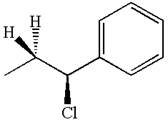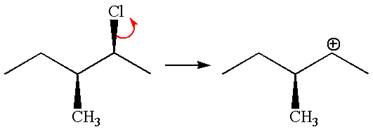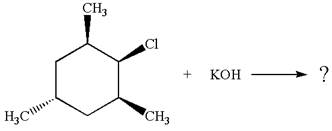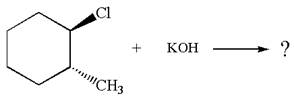
Concept explainers
(a)
Interpretation:
The detailed mechanisms for the given reaction occurring via
Concept introduction:
The
In case of
Answer to Problem 8.44P
The


The

Explanation of Solution
The given reaction equation is:

In the given reaction,

The hydrogen atom, indicated with the dash bond, is anti to

If the hydrogen atom, indicated with wedge bond, tends to eliminate, it must orient anti to

In

The products formed for the given reaction from both
(b)
Interpretation:
The detailed mechanisms for the given reaction occurring via
Concept introduction:
The
In case of
Answer to Problem 8.44P
The

The

Explanation of Solution
The given reaction equation is:

In the given reaction,

In

The products formed for the given reaction from both
(c)
Interpretation:
The detailed mechanisms for the given reaction occurring via
Concept introduction:
The
In case of
Answer to Problem 8.44P
The


The



Explanation of Solution
The given reaction equation is:

In the given reaction,


In

In the second step, the base abstracts the proton from the carbon adjacent to the positively charged carbon. Two products are possible because the proton gets eliminated from two different carbon atoms. The detailed mechanism is shown below:


The products formed for the given reaction from both
(d)
Interpretation:
The detailed mechanisms for the given reaction occurring via
Concept introduction:
The
In case of
Answer to Problem 8.44P
The


The





Explanation of Solution
The given reaction equation is:

In the given reaction,


In

In the second step, the base abstracts the proton from the carbon adjacent to the positively charged carbon. Two products are possible from the secondary carbocation because the proton is eliminated from two different carbon atoms.


The carbocation formed is a secondary carbocation, which can be rearranged to a more stable tertiary carbocation by

Two products are possible from the tertiary carbocation because the proton is eliminated from two different carbon atoms.


Thus, in all the reactions above, the products are formed by
The products formed for the given reaction from both
(e)
Interpretation:
The detailed mechanisms for the given reaction occurring via
Concept introduction:
The
In case of
Answer to Problem 8.44P
The


The



Explanation of Solution
The given reaction equation is:

In the given reaction,


In

In the second step, the base abstracts the proton from the carbon adjacent to the positively charged carbon. Two products are possible because the proton is eliminated from two different carbon atoms. The detailed mechanism is shown below:


The products formed for the given reaction from both
(f)
Interpretation:
The detailed mechanisms for the given reaction occurring via
Concept introduction:
The
In case of
Answer to Problem 8.44P
The

The





Explanation of Solution
The given reaction equation is:

In the given reaction,

In

In the second step, the base abstracts the proton from the carbon adjacent to positively charged carbon. Two products are possible because the proton is eliminated from two different carbon atoms. The detailed mechanism is shown below:


The carbocation formed is a secondary carbocation, which can be rearranged to form more stable tertiary carbocation by

Two products are possible from the tertiary carbocation because the proton IS eliminated from two different carbon atoms.


The products formed for the given reaction from both
Want to see more full solutions like this?
Chapter 8 Solutions
ORGANIC CHEMISTRY PRINCIPLES & MECHANISM
- 1. Show the steps necessary to make 2-methyl-4-nonene using a Wittig reaction. Start with triphenylphosphine and an alkyl halide. After that you may use any other organic or inorganic reagents. 2. Write in the product of this reaction: CH3 CH₂ (C6H5)₂CuLi H₂O+arrow_forward3. Name this compound properly, including stereochemistry. H₂C H3C CH3 OH 4. Show the step(s) necessary to transform the compound on the left into the acid on the right. Bri CH2 5. Write in the product of this LiAlH4 Br H₂C OHarrow_forwardWhat are the major products of the following reaction? Please provide a detailed explanation and a drawing to show how the reaction proceeds.arrow_forward
- What are the major products of the following enolate alkylation reaction? Please include a detailed explanation as well as a drawing as to how the reaction proceeds.arrow_forwardA block of zinc has an initial temperature of 94.2 degrees celcius and is immererd in 105 g of water at 21.90 degrees celcius. At thermal equilibrium, the final temperature is 25.20 degrees celcius. What is the mass of the zinc block? Cs(Zn) = 0.390 J/gxdegrees celcius Cs(H2O) = 4.18 J/gx degrees celcusarrow_forwardPotential Energy (kJ) 1. Consider these three reactions as the elementary steps in the mechanism for a chemical reaction. AH = -950 kJ AH = 575 kJ (i) Cl₂ (g) + Pt (s) 2C1 (g) + Pt (s) Ea = 1550 kJ (ii) Cl (g)+ CO (g) + Pt (s) → CICO (g) + Pt (s) (iii) Cl (g) + CICO (g) → Cl₂CO (g) Ea = 2240 kJ Ea = 2350 kJ AH = -825 kJ 2600 2400 2200 2000 1800 1600 1400 1200 1000 a. Draw the potential energy diagram for the reaction. Label the data points for clarity. The potential energy of the reactants is 600 kJ 800 600 400 200 0 -200- -400 -600- -800- Reaction Progressarrow_forward
- Can u help me figure out the reaction mechanisms for these, idk where to even startarrow_forwardHi, I need your help with the drawing, please. I have attached the question along with my lab instructions. Please use the reaction from the lab only, as we are not allowed to use outside sources. Thank you!arrow_forwardHi, I need your help i dont know which one to draw please. I’ve attached the question along with my lab instructions. Please use the reaction from the lab only, as we are not allowed to use outside sources. Thank you!arrow_forward
- 5. Write the formation reaction of the following complex compounds from the following reactants: 6. AgNO₃ + K₂CrO₂ + NH₄OH → 7. HgNO₃ + excess KI → 8. Al(NO₃)₃ + excess NaOH →arrow_forwardIndicate whether the product formed in the reaction exhibits tautomerism. If so, draw the structure of the tautomers. CO₂C2H5 + CH3-NH-NH,arrow_forwardDraw the major product of this reaction N-(cyclohex-1-en-1-yl)-1-(pyrrolidino) reacts with CH2=CHCHO, heat, H3O+arrow_forward
 Organic Chemistry: A Guided InquiryChemistryISBN:9780618974122Author:Andrei StraumanisPublisher:Cengage Learning
Organic Chemistry: A Guided InquiryChemistryISBN:9780618974122Author:Andrei StraumanisPublisher:Cengage Learning
